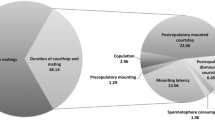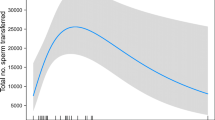Abstract
Matings and acts of cannibalism were observed in the crab spiderPhilodromus vulgaris, some of which were carrying a first-instar larva of the mantispidMantispa uhleri. Larval mantispids did not transfer during the copulation of their spider hosts but did switch from spider to spider during cannibalism. Twenty-three of 27 total cannibalisms in which the cannibalized spider carried a larva resulted in larval transfers, for a transfer rate of 85%. Copulation times inP. vulgaris were found to be extremely short in comparison to lycosids such asSchizocosa ocreata, whose long copulation time supports the larval transfer ofClimaciella brunnea. The time required for larval transfer during cannibalism inP. vulgaris was measured. Cannibalisms were much longer than copulations but larvae transferred to the cannibalizing spider in a comparatively short period of time.
Similar content being viewed by others
References
Costa, F. G., and Sotelo, J. R., Jr. (1984). Influence of temperature on the copulation duration ofLycosa malitosa Tullgren (Araneae, Lycosidae).J. Arachnol. 12: 273–277.
George, L. D., and George, N. L. (1975). Notes on the three hundred and fifty-eighth meeting: A new record of mantispid reared from spider.Pan-Pacif. Entomol. 51: 90.
Hoffman, K. M. (1989). Taxonomic status ofMantispa sayi, Mantispa fuscicornis, andMantispa uhleri (Neuroptera: Mantispidae).Proc. Entomol. Soc. Wash. 91: 637–639.
Hoffman, K. M., and Brushwein, J. R. (1989). Species of spiders (Araneae) associated with the immature stages ofMantispa pulchella (Neuroptera: Mantispidae).J. Arachnol. 17: 7–14.
Hoffman, K. M., and Brushwein, J. R. (1990). Spider (Araneae) taxa associated with the immature stages ofMantispa interrupta (Neuroptera: Mantispidae).Entomol. News 101: 23–28.
Hoffman, K. M., and Brushwein, J. R. (1992). Descriptions of the larvae and pupae of some North American Mantispinae (Neuroptera: Mantispidae) and development of a system of larval chaetotaxy for Neuroptera.Trans. Am. Entomol. Soc. 118: 159–196.
LaSalle, M. W. (1986). Note on the mantispidClimaciella brunnea (Neuroptera: Mantispidae) in a coastal marsh habitat.Entomol. News 97: 7–10.
Montgomery, T. H. (1903). Studies on the habits of spiders particularly those of the mating period.Proc. Acad. Nat. Sci. Phila. 55: 59–149.
Redborg, K. E. (1983). A mantispid larva can preserve its spider egg prey: Evidence for an aggressive allomone.Oecologia 58: 230–231.
Redborg, K. E., and MacLeod, E. G. (1983).Climaciella brunnea (Neuroptera: Mantispidae): A mantispid that obligately boards spiders.J. Nat. Hist. 17: 63–73.
Redborg, K. E., and MacLeod, E. G. (1984). Maintenance feeding of first instar mantispid larvae (Neuroptera, Mantispidae) on spider (Arachnida, Araneae) hemolymph.J. Arachnol. 11: 337–341.
Redborg, K. E., and MacLeod, E. G. (1985). The developmental ecology ofMantispa uhleri Banks (Neuroptera: Mantispidae).Ill. Biol. Monogr. 53: 1–130.
Redborg, K. E., and Redborg, A. H. (1996). Resource partitioning of spider hosts (Arachnida, Araneae) by two mantispid species (Neuroptera, Mantispidae) in an Illinois woodland (submitted for publication).
Rice, M. E., and Peck, W. B. (1991).Mantispa sayi (Neuroptera: Mantispidae) parasitism on spiders (Araneae) in Texas with observations on oviposition and larval survivorship.Ann. Entomol. Soc. Am. 84: 52–57.
Rovner, J. S. (1974). Copulation in the lycosid spiderSchizocosa saltatrix (Hentz): An analysis of palpal insertion patterns.Anim. Behav. 22: 94–99.
Scheffer, S. (1992). Transfer of a larval mantispid during copulation of its spider host.J. Insect Behav. 5: 797–801.
Stratton, G. E. (1982).Reproductive Behavior and Behavior Genetics in SchizocosaWolf Spiders, Ph.D. dissertation, University of Cincinnati, Cincinnati, OH.
Vittitoe, D. A. (1991).A Possible Anti-mantispid (Neuroptera: Mantispidae) Behavioral Mechanism in the Spider Philodromus vulgaris(Hentz) (Araneae: Philodromidae), Honors thesis, Coe College, Cedar Rapids, IA.
Author information
Authors and Affiliations
Rights and permissions
About this article
Cite this article
O’Brien, L.C., Redborg, K.E. Copulation duration in the spiderPhilodromus vulgaris (Hentz) (Araneae: Philodromidae) and its influence on the evolution of host transfer behavior during cannibalism byMantispa uhleri banks (Neuroptera: Mantispidae). J Insect Behav 10, 469–477 (1997). https://doi.org/10.1007/BF02765371
Received:
Revised:
Issue Date:
DOI: https://doi.org/10.1007/BF02765371




